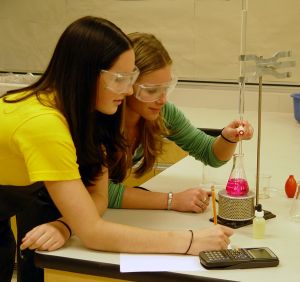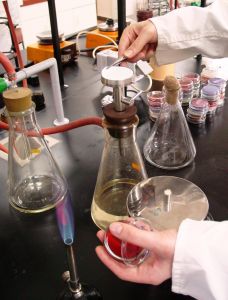Supercharged Science Program Overview and Interview with Founders
Al Lipper and his wife, Aurora, are creators of Supercharged Science. They specialize in teaching science in ways that really inspire and motivate kids – even kids who were totally disinterested with more traditional science teaching approaches.
What is Supercharged Science and will it work for my family?

Their flagship science program at Supercharged Science is called e-Science. It's a complete online homeschool science program that appears to achieve an extraordinary degree of success when it comes to teaching science to homeschool kids. Al attributes it to the unique approach they take to teaching.
Today, Al has agreed to pull back the curtain and share with us the underlying concepts that have made e-Science from Supercharged Science such a uniquely effective program.
1.What is the best way to teach Science?
This is a great question. So often parents think that teaching science is a matter of getting kids to understand concepts like Newton’s laws or know what each part of a cell is. The good news is (especially for parents who aren’t great at science themselves), this is not what’s most important in teaching science.
In all the years I’ve been teaching science, the single most important factor I’ve found in a kids’ ability to learn science in a meaningful way is interest and motivation. When I say meaningful, I mean learning it in a way that’s they’ll be able to use in later grades, in college, and honestly, when they get out into the working world. So much of what kids learn is stuff they forget in a few weeks. The kind of learning I’m talking about is for a lifetime.
I mean, if you know a good scientist – like an engineer, doctor, researcher or someone like that, ask them how they first got interested in it. Almost all of them have a similar beginning to their story. Something like “When I was a kid, I was always pulling apart old radios and stuff…. I was always building inventions in the basement…” This is what learning science is REALLY about. I mean, they never say “Well, I memorized the parts of a cell and it was so exciting that I decided to be a doctor.” It's always their intrinsic excitement with discovery that drives them.
So, the key to getting your kids to learn science really well is to get them excited and motivated. You do this by first showing them a good reason why they should care. Once they are interested, then you introduce the academic material.
For example, if you want to teach a kid about aerodynamics, don’t start with a textbook. Instead, arrange for him to get a ride in a small plane. Again, the key is to get your kids really excited, then the academics will follow.
2. What are the advantages of the way you teach science at Supercharged Science over other methods of teaching homeschool science?
The main advantage as I see it is that with Supercharged Science kids are learning science in a way that will be genuinely useful to them in their lives – both in their future schooling as well as when they go out looking for a job someday. Even if they’re young now, having a genuine fascination with science creates the foundation of whatever form science and technology might take in their future.
The way we teach it in e-Science starts with hands-on projects. This is what gets kids really excited and engaged. Once they think the project is cool, then they want to learn the academic part. It’s the most effective way I’ve ever seen science taught.
3. Are there any disadvantages to teaching science with a hands on approach like Supercharged Science?
The disadvantages are more perceived than real. It takes more time to do hands-on experiments and projects than to just read a textbook. But the textbook stuff is usually forgotten within weeks. In that sense, it was largely wasted time. I mean how much do you remember from what you read in your middle school science book? On the other hand, hands-on science is what kids remember for decades. This is what really counts.
The other aspect than can be a disadvantage is that obviously you need to buy parts and pieces to do experiments. This can be frustrating because parents don’t always know what to buy. We address this in our programs by using easy-to get, inexpensive parts and giving detailed shopping lists to parents. I mean, we even tell parents where to shop.
It takes more work to teach hands-on science, but I think you have to ask yourself “Why do I really want my kid to learn science?” If you really want your kids to learn science in a way that will count in their lives, then hands-on is the best way to go.
4. What involvement does the parent have in this process of teaching science as you recommend in Supercharged Science?
This depends on whether the parent designs the program themselves or they get a pre-designed program or curriculum. It can be pretty time-consuming to do it yourself, but if you really enjoy it, it can be a great process to go through with your child. You both learn as you go along. But this is a very time-consuming approach if you want to do it well.
If you don’t have the time or background to do it yourself, then there are a variety of choices for pre-designed programs. Whichever program you choose, make sure it has hands-on experiments and activities as a primary focus.
If you want to get the most effective learning per hour of study, video-based programs can’t be matched. There’s just so much more that can be conveyed through a video showing step-by-step how to do an experiment. And I don’t mean silly animated cartoon-character video clips. I’m talking about videos that show real teachers or scientists demonstrating and explaining. Diagrams and drawings in books just can’t come close to showing how to build a particular experiment or illustrating how something like an engine works.
Some programs allow kids to work more independently and are designed to be self-guided, others require more parent involvement. Make sure the program you get matches the style you want to use. Some require lots of parent involvement and can’t be used independently. And some programs accommodate both styles.
For example, in our e-Science program at Supercharged Science, we’ve arranged it so it can be self-guided. We make use of detailed videos and carefully-structured lessons so that that our programs are self-guided. This makes it so a parent can just say “Go do your science.” And the program will guide their child step-by-step through the science lesson. Of course, parents can also choose to do it with their kids, but the point is, they don’t have to.
Other than having
live science teachers and labs, I don’t think you can beat a combination
of hands-on experiments and quality videos for teaching homeschool
science.

5. Do you recommend the mom watching the videos and going through the Supercharged Science course first to get familiar with it or can the student use it without much help?
This entirely depends on the program you choose. Most of the popular science curriculums are based on textbook-type reading with a few experiments thrown in to demonstrate some concept. Often these experiments require the parents to learn them first because they’re hard to get to work right. This is frustrating and time-consuming.
When you use a program that has been kid-tested and makes effective use of video, then a mom shouldn’t need to go through the course before her kids use it. This was one of our goals at Supercharged Science from the very beginning when we created the e-Science program.
6. Any advice for new homeschoolers?
Yes. Figure out why you want your child to learn science before choosing a program of any kind. I mean, is it to do better in school down the road? To get into a good college someday? Because it’s an important skill these days? (After all, science and technology jobs pay about 30% more than other jobs for the same amount of education). Figure out your reasons.
Next, choose a science program that focuses on quality, not quantity. Get a program that emphasizes getting your kid really excited about science. I mean really interested in it. If you do this, the academic part is easy. If not, well we all know what a struggle it can be to get kids to do something they don’t really care about. Make science count for them. Pick a program that is fun and exciting.
7. Any other advice you would give homeschoolers about picking a science program?
Make sure you can try it before you buy it. Or that you can get your money back if it’s not right for you and your kids.
No program is right for every kid. Try it out and see if it gets them excited and interested. See if they can go through it on their own, if that’s important to you. We get emails all the time from parents who say things like “My son never cared for science before. But now, he’s been late for dinner three nights in a row because he doesn’t want to stop his e-Science lesson!” Whatever program you choose, it should inspire your kid like this.
Al Lipper has been teaching for over 20 years. He holds graduate degrees in education and psychology.
To get started with over 30 free homeschool science experiments from Supercharged Science, download the free Science Activity and Experiment Guide.
Are you set to teach science in the fall? Click here for free science videos and experiments
Aurora Lipper has just opened Supercharged Science fall enrollment on her top-of-the-line e-Science curriculum. She's offering this outrageous deal right now where you can enroll your kids for just $1 for the first month. No catch, no strings attached.
Check it out here.